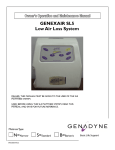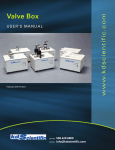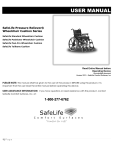Download Research Grade Blood Pressure Transducer User`s Manual
Transcript
Research Grade Blood Pressure Transducer User's Manual Research Grade Blood Pressure Transducer, 110 VAC/60 Hz Research Grade Blood Pressure Transducer, 220 VAC/50 Hz MA1 60-3002 MA1 60-3003 Publication 5408-002-REV-A Publication 5408-002-REV-A WEEE/RoHS Compliance Statement EU Directives WEEE and RoHS To Our Valued Customers: We are committed to being a good corporate citizen. As part of that commitment, we strive to maintain an environmentally conscious manufacturing operation. The European Union (EU) has enacted two Directives, the first on product recycling (Waste Electrical and Electronic Equipment, WEEE) and the second limiting the use of certain substances (Restriction on the use of Hazardous Substances, RoHS). Over time, these Directives will be implemented in the national laws of each EU Member State. Once the final national regulations have been put into place, recycling will be offered for our products which are within the scope of the WEEE Directive. Products falling under the scope of the WEEE Directive available for sale after August 13, 2005 will be identified with a “wheelie bin” symbol. Two Categories of products covered by the WEEE Directive are currently exempt from the RoHS Directive – Category 8, medical devices (with the exception of implanted or infected products) and Category 9, monitoring and control instruments. Most of our products fall into either Category 8 or 9 and are currently exempt from the RoHS Directive. We will continue to monitor the application of the RoHS Directive to its products and will comply with any changes as they apply. • Do Not Dispose Product with Municipal Waste • Special Collection/Disposal Required Table of Contents Harvard Apparatus Research Grade Blood Pressure Transducer User ’s Manual 1 SUBJECT PAGE NO. Warranty and Repair Information ........................2 Theory of Operation ..............................................3 General Information: Specifications..................................................4 Amplifier/Power Supply ..................................4 Front Panel Control ........................................4 Electrical Output ............................................5 Maintenance and Storage ..............................5 Serial Number ................................................5 Replacement Parts ........................................5 Operation: Installing the Dome ........................................6 Liquid Connections ........................................7 Filling and Purging of Air ................................8 Publication 5408-002-REV-A Warranty and Repair Information Harvard Apparatus Research Grade Blood Pressure Transducer User ’s Manual 2 CAUTION: Avoid placing force on sensing button when dome is not installed. Do not allow liquid to enter sensing head since serious damage will result. Transducer sensing head may not survive being dropped. Serial Numbers All inquires concerning our product should refer to the serial number of the unit(s). W a rr a n t y Harvard Apparatus warranties the instrument(s) for a period of two years from date of purchase.At its option, Harvard Apparatus will repair or replace the unit(s) if it is found to be defective as to workmanship or material. This warranty does not extend to damage resulting from misuse, neglect or abuse, normal wear and tear, or accident. This warranty extends only to the original customer purchaser. IN NO EVENT SHALL HARVARD APPARATUS BE LIABLE FOR INCIDENTAL OR CONSEQUENTIAL DAMAGES. Some states do not allow exclusion or limitation of incidental or consequential damages so the above limitation or exclusion may not apply to you. THERE ARE NO IMPLIED WARRANTIES OF MERCHANTABILITY, OR FITNESS FOR A PARTICULAR USE, OR OF ANY OTHER NATURE. Some states do not allow this limitation on an implied warranty, so the above limitation may not apply to you. If a defect arises within the two-year warranty period, promptly contact Harvard Apparatus, Inc. 84 October Hill Road, Holliston, Massachusetts 01746-1371 using our U.S. only toll free number 1-800-272-2775 or dial (508) 893-8999. Goods will not be accepted for return unless an RMA (returned materials authorization) number has been issued by our customer service department. The customer is responsible for shipping charges. Please allow a reasonable period of time for completion of repairs, replacement and return. If the unit is replaced, the replacement unit is covered only for the remainder of the original warranty period dating from the purchase of the original device. This warranty gives you specific rights, and you may also have other rights which vary from state to state. R e p a i r F a c i l i t i e s a n d P a rt s Harvard Apparatus stocks replacement and repair parts. When ordering, please describe parts as completely as possible, preferably using our part numbers. If practical, enclose a sample or drawing.We offer a complete reconditioning service. CAUTION: Not for clinical use on human patients. Publication 5408-002-REV-A Theory of Operation Harvard Apparatus Research Grade Blood Pressure Transducer User ’s Manual 3 This Blood Pressure Transducer converts pressure to a proportional DC voltage value. A transparent plastic dome with two Luer-lock fittings contains the liquid whose pressure values are to be monitored. One of the Luer-lock fittings is used for connecting tubing to the source to be monitored and the other to purge air that would otherwise markedly degrade the transducer’s dynamic (i.e. changing) response capabilities. The dome has an internal membrane that contacts a button on the sensing head. Liquid pressure within the dome acts through the membrane to produce a force upon the button. The force, in turn, acts against a rigid flexure-spring assembly to produce a small increment of motion which is measured by a differential capacitor circuit housed within the sensing head. From here, a cable carries the electrical signal to the power supply where the signal is further amplified and calibrated for the purposes of gain and offset. In addition, an external offset control will facilitate correction for static pressure. Sensing Head Mounting Shaft Dome Signal Cable Amplifier/Power Supply External Offset Control PRESSURE TRANSDUCER mm Hg OFFSET 12 Volt AC Wall Transformer 12 Volt AC Cable Figure 1. Research Grade Blood Pressure Transducer Publication 5408-002-REV-A General Information Harvard Apparatus Research Grade Blood Pressure Transducer User ’s Manual 4 Specifications Input Two Luer-lock connectors on transparent polycarbonate plastic dome with internal silicone rubber membrane Internal Volume 300 µ l, approx Compliance 14 µ l of displacement/100 mm pressure including 30.5 cm (12 in) of standard 3 mm ID vinyl tubing Sterilization Chemical – Alcide or Cidex Pressure Range -10 to +300 mmHg Natural Frequency (Dry) > 500 Hz Membrane Pressure 300 mmHg without rupture and dome not installed Overload Pressure 3,000 mmHg with dome installed Output Voltage Factory set at 1.0 V/100 mmHg Digital Panel Meter Reads in “mmHg” (output voltage x 100) Offset Control Adjusts from +50 mmHg (0.5 V) to -100 mmHg (1.0 V) Carrier Frequency 2 MHz Sensing Head Dimensions 32 x 45 x 42 mm (1.26 x 1.77 x 1.65 in) Transducer Weight 70 g (2-1/2 oz) Amplifier/Power Supply a) The entire transducer is powered by a 12 volt AC wall transformer. b) There is no ON/OFF switch. The unit can remain powered, as shown on the digital meter, for the entire experiment. F ro n t P a n e l C o n t ro l The offset knob on the front panel is used to set a zero output voltage for any static pressure up to 100 mmHg. Publication 5408-002-REV-A General Information 5 Harvard Apparatus Research Grade Blood Pressure Transducer User ’s Manual Electrical Output a) Binding post are provided on the power supply for output connections. Red is positive (+); black is negative (–) and also ground. b) Output voltage is 1.0 V/100 mmHg pressure up to 300 mmHg. Output impedance is 2 kΩ for direct connection to all recorders. c) The digital panel meter, calibrated in mmHg, reads output voltage x 100. d) High, Low, and Offset trim pots are factory calibrated. DO NOT adjust. Binding Posts High-Gain Trim _ Low-Gain Trim + Offset Trim To Transducer Sensing Head 12 Volt AC Cable Figure 2. Electrical Output Maintenance and Storage a) No special precautions are required other than keeping a dome installed at all times and preventing liquids from entering the sensing head. b) When not in use, store in a clean, dry place. Serial Number The serial number is located on the power supply circuit board. Refer to this number in any correspondence. R e p l a c e m e n t P a rt s Catalog No. Product 52-9990 Replacement Domes, pkg of 2 Publication 5408-002-REV-A Operation 6 Harvard Apparatus Research Grade Blood Pressure Transducer User ’s Manual Installing the Dome Install the dome and make liquid connections. Take care to avoid cross-threading. The threads will engage smoothly, and finger tightening is adequate. Liquid Connections Orienting one of the Luer-lock fittings vertically will facilitate clearing air bubbles when filling with liquid. The dome may be installed empty or filled with liquid. In either case, make sure that the pressure in the dome does not exceed 300 mmHg. Otherwise, the membrane may rupture. Once installation is complete, the membrane is supported by the sensing button. Signal Cable (To Amplifier/Power Supply) Luer-Lock Fittings Dome Mounting Shaft Sensing Head Figure 3. Sensing Head Publication 5408-002-REV-A Operation 7 Harvard Apparatus Research Grade Blood Pressure Transducer User ’s Manual F i l l i n g a n d P u rg i n g A i r The presence of trapped air bubbles anywhere within the liquid column will add compliance to the system and degrade the transducer’s dynamic response capabilities. For this reason, it is recommended that the dome, tubing, and lumen be filled with a continuous flush until all bubbles have been cleared from the system. The dome cavity is shaped like a cone with one Luer-lock fitting at the tip (apex) and the other to the side (lateral). Flushing in the side and out the tip while held vertically allows the bubbles to rise. Tapping with a finger may be required to dislodge additional bubbles. Be sure to provide sufficient opening to allow fluid to escape and thereby prevent excessive pressure build-up which may rupture the dome. This precaution is especially important when filling an unmounted dome since the membrane is not supported and can withstand only 300 mmHg. Thus, installing the dome on the sensing head before filling is the safest procedure, but may not always be possible. Close off the filling tube with a stopcock or by pinching it. Publication 5408-002-REV-A
























